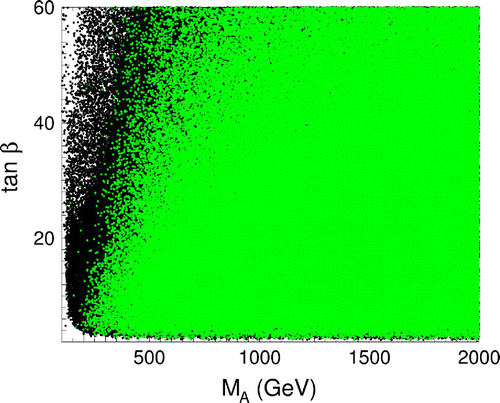 ?Mathematical formulae have been encoded as MathML and are displayed in this HTML version using MathJax in order to improve their display. Uncheck the box to turn MathJax off. This feature requires Javascript. Click on a formula to zoom.
?Mathematical formulae have been encoded as MathML and are displayed in this HTML version using MathJax in order to improve their display. Uncheck the box to turn MathJax off. This feature requires Javascript. Click on a formula to zoom.Abstract
The Minimal Supersymmetric extension of the Standard Model (MSSM) provides suitable candidates for cold dark matter. We discuss here the constraints from dark matter direct detection and cosmological dark matter density, as well as LHC data from Higgs, SUSY and monojet searches, and flavour physics data, in the context of the phenomenological MSSM (pMSSM) with neutralino dark matter. We show that the complementarity of the different sectors is essential to probe the pMSSM parameter space.
Keywords:
Public Interest Statement
Cosmological and astrophysical observations reveal that dark matter constitutes the major part of matter in the Universe. Yet, the current Standard Model of particle physics does not provide any particle candidate to explain its nature. The supersymmetric extension of the Standard Model suggests that dark matter could be made of neutralinos, which is a neutral and weakly interacting particle not been discovered yet. In this paper, the authors investigate the current constraints on supersymmetric dark matter, by considering simultaneously the results from cosmological observations, dark matter particle detection experiments, as well as LHC searches for new particles.
1. Introduction
The Minimal Supersymmetric extension of the Standard Model (MSSM) is one of the most studied new physics models. When -parity is conserved, supersymmetric particles can only be produced in pairs off Standard Model (SM) particles, and the lightest supersymmetric particle (LSP) is stable. If the LSP is neutral and weakly interacting, it can constitute a suitable dark matter candidate. This is the case of the lightest neutralino, which interacts weakly enough to make an ideal dark matter candidate. Studies in the MSSM however suffer from the large number of parameters—more than a hundred—which makes a systematic analysis impossible. On the other hand, constrained MSSM scenarios, such as the constrained MSSM, have only a handful of parameters, but cover only a small region of the MSSM parameter space. The phenomenological MSSM (pMSSM) (Djouadi, CitationXXXX) offers a convenient compromise: it is the most general version of the MSSM with CP and
-parity conservations respecting minimal flavour violation, which has 19 independent parameters. In this work, we will concentrate on the pMSSM with neutralino dark matter. We study its 19 parameter space by performing flat scans on all the parameters, as described in Arbey, Battaglia, and Mahmoudi (Citation2012b,Citation2012c), for masses up to 3.5 TeV. Other analyses in the pMSSM can be found for example in AbdusSalam, Allanach, Quevedo, Feroz and Hobson (Citation2010), Conley, Gainer, Hewett, Le, and Rizzo (CitationXXXX), Sekmen et al. (Citation2012), Cahill-Rowley, Hewett, Hoeche, Ismail, and Rizzo (Citation2012), CMS Collaboration (CitationXXXXa,CitationXXXXb), Kowalska, Roszkowski, Sessolo, and Trojanowski (Citation2014), Cahill-Rowley et al. (Citation2015). In the following, we first consider LHC constraints from supersymmetry (SUSY) and monojet searches. In Section 3, we study the consequences of the Higgs boson discovery. In Section 4, we account for constraints from flavour physics. The results of dark matter searches are discussed in Section 5. Finally, we consider all the constraints simultaneously to assess their complementarity, before concluding in Section 6.
2. SUSY and monojet searches at the LHC
We first consider the constraints from SUSY and monojet searches at the LHC in the context of the pMSSM. Since supersymmetric particles are pair produced and the LSP is stable, supersymmetric search channels at the LHC feature elusive neutralinos in the final state. Hence, the experimental signatures consist in final states with missing transverse energy (MET). In this analysis, we consider the jets+MET channels, relevant for the search for first and second generation squarks and gluinos (ATLAS Collaboration, CitationXXXXa), as well as -tagged jets+MET channels for sbottom and stop searches (ATLAS Collaboration, CitationXXXXb), and chargino/neutralino searches in two leptons+MET (ATLAS Collaboration, CitationXXXXc) and three leptons+MET (ATLAS Collaboration, CitationXXXXd) channels. We generate the events with PYTHIA 8.1 (Sjostrand, Mrenna, & Skands, Citation2008), with the CTEQ6L1 parton distribution functions (Pumplin et al., Citation2002). Detector simulation is performed with DELPHES 3.0 (Ovyn, Rouby, & Lemaitre, CitationXXXX).
Figure 1. Schematic representation of monojet channels in the effective or simplified models (left panel) and additional diagrams in the MSSM with neutralino dark matter (right panel).

Contrary to the previous analyses in the pMSSM, here, we systematically use the monojet search results, which are particularly important in the case of compressed spectra. To study the consequences of the monojet searches on the pMSSM parameter space, we have designed a specific method to reinterpret the monojet search data in the context of the MSSM, as described in Arbey, Battaglia and Mahmoudi (Citation2014). Monojet channels consist of one hard jet+MET in the final state. The results are usually presented in effective or simplified models (ATLAS Collaboration, CitationXXXXe; CMS Collaboration, CitationXXXXc), in which the final state is interpreted as generated by two dark matter particles and one jet, as shown in the left panel of Figure . However, within a specific model like the MSSM, there are other means to generate a monojet final state at the LHC. In particular, since the LHC is a hadronic machine, the production of squarks and gluinos which have larger cross sections is more likely. Moreover, in compressed MSSM scenarios, the squarks, gluinos and neutralinos can have similar masses, so that the squark or gluino would mostly decay to soft jet(s) + one neutralino. Due to the cuts applied in the monojet searches, the soft jet(s) will not be observed, and the final state with two squarks/gluinos + one hard jet will be the same as the typical monojet signature. Such a topology is presented in the right panel of Figure . For this reason, to assess the implications of the monojet searches in the MSSM, it is important to consider the processes , where
is a hard jet and (N)LSP stands for the (next-to-)LSPs. We compute the matrix elements corresponding to the full diagrams with MadGraph 5 (Alwall et al., Citation2014) and generate events using the CTEQ6L1 parton distribution functions. The parton showering is performed with PYTHIA 6 (Sjostrand, Mrenna, & Skands, Citation2006), and detector simulation with DELPHES 3.0. We consider the ATLAS and CMS monojet results (ATLAS Collaboration, CitationXXXXe; CMS Collaboration, CitationXXXXc) to obtain the exclusion of the pMSSM points by the monojet searches.
In Figure , we show the difference of exclusion potential between the case where only neutralino LSPs are considered in the monojet final states (left panel), and the case with in addition squarks and gluinos decaying to soft jets and neutralinos (right panel), for the LHC 14 TeV run with 300 fb. As can be seen from the figure, considering the squark and gluino final states would lead to a large increase in the monojet production cross section, enhancing substantially the monojet sensitivity.
Figure 2. Monojet production cross section as a function of the neutralino mass, in the case where only neutralino LSPs are considered in the monojet final states (left panel), and in the case with squarks and gluinos decaying to soft jets and neutralinos (right panel), for the LHC 14 TeV run with 300 fb. The blue points satisfy the monojet constraints, while the red points are excluded at 95% C.L.
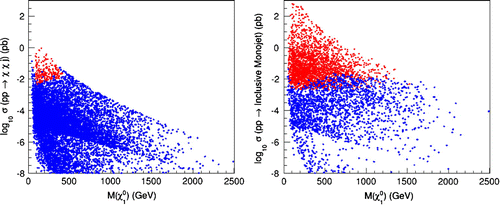
The current exclusion limits by the SUSY and monojet searches are presented in Figure as functions of the lightest squark and gluino masses. As expected the direct SUSY searches strongly probe the small squark and gluino masses, and the monojet searches nicely complement them up to an exclusion of close to 100% of the points for masses below 400 GeV. In Figure , the excluded points are presented in two-dimensional plots, in the lightest squark/gluino vs. neutralino mass plane and in the lightest squark/gluino mass splitting with the neutralino vs. neutralino mass plane. We see that the SUSY searches can probe squark/gluino masses up to 1.5 TeV when the neutralino is light, whereas the monojet searches improve the constraints on the neutralino mass by 100 GeV for small mass splittings. This shows the important complementarity between the SUSY and monojet searches, in particular when investigating compressed scenarios with small mass splittings.
Figure 3. Fraction of excluded points by the SUSY searches (solid lines) in addition to the monojet searches (dotted lines), as a function of the lightest squark mass (left panel) and of the gluino mass (right panel).
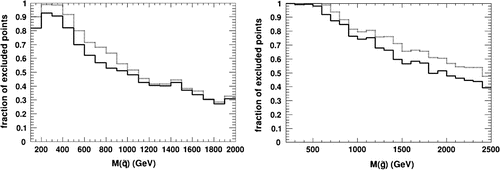
Figure 4. Fraction of excluded points in the lightest squark/gluino vs. neutralino mass plane (left panel) and the lightest squark/gluino mass splitting with the neutralino vs. neutralino mass plane (right panel). Notes: The grey zones correspond to regions where no valid pMSSM point is found. The grey line delimits the region where 99% of the points are excluded by the SUSY searches only, and the yellow line the region where the points are excluded by the combination of the SUSY and monojet searches (Arbey et al., Citation2014).
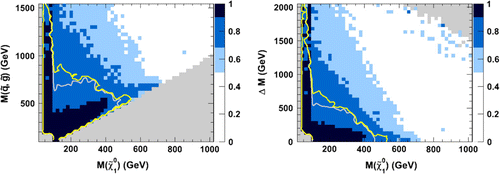
3. Higgs searches
The discovery of a Higgs boson at 125 GeV (Aad et al., Citation2012; Chatrchyan et al., Citation2012) has strong implications for the MSSM, as it can be considered to be the lightest MSSM Higgs boson . In the MSSM, the lightest Higgs mass and couplings are mainly determined by the parameters
(CP-odd Higgs mass),
(geometric average of the stop masses),
(stop mixing parameter) and
. To obtain a Higgs mass of 125 GeV, it is necessary to have a large
or a large
(Arbey, Battaglia, Djouadi, Mahmoudi, & Quevillon, Citation2012). In our scans, we impose a Higgs mass of
GeV to account for the experimental and theoretical uncertainties, and consider the measured signal strengths in the
,
,
,
and
channels, and impose the limits from heavier Higgs
searches, as described in Arbey, Battaglia, Djouadi, and Mahmoudi (Citation2012a,Citation2012b). The results are presented in Figure in the
and
parameter planes. It is clear that large values of
(
GeV) and
are favoured by the current measurements.
Figure 5. pMSSM points in agreement with the Higgs measurements projected on the (left panel) and
(right panel) parameter planes. Notes: The black points are in agreement with the Higgs mass and
constraints. The dark and light green points are compatible at 68% and 95% C.L. with the additional
signal strength measurements, respectively (Arbey et al., Citation2012b).
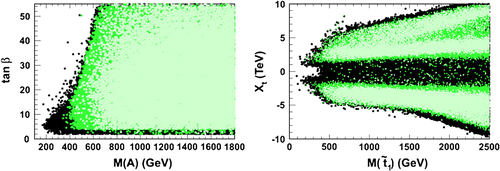
Figure 6. Fraction of excluded points (blue scale) by the heavy Higgs searches for the 8 TeV run (left panel) and extrapolations for the 14 TeV run (right panel). Notes: The lines delimit the excluded regions from different heavy Higgs search channels (Arbey, Battaglia, & Mahmoudi, Citation2013b).

The searches for heavier Higgs states can impose further constraints on the MSSM parameter space. In Figure , the constraints obtained from the searches at 8 TeV for ,
and
are shown in the left panel.
gives the strongest constraints, particularly important at large
. The
channel on the other hand provides constraints in the small
region, which are complementary to the constraints from the light Higgs signal strength measurements. In the right panel, extrapolations for the 14 TeV run are provided for the same channels, as well as for
. As can be seen,
searches will probe a much larger parameter space, while
will provide complementary information at small
.
4. Flavour physics constraints
physics observables provide also additional constraints on the pMSSM parameter space. In particular, the branching ratio of
is of interest since it can receive large contributions from scalar and pseudoscalar operators in the MSSM. Using SuperIso (Mahmoudi, Citation2008,Citation2009), we have computed and studied the constraints from this observable on the pMSSM. In Figure , we present the constraints from BR(
) in the
and
parameters planes. As can be seen, the branching fraction of
is particularly constraining at large
and disfavours small
and
. In this respect, it is complementary to the Higgs searches, and in particular the
channel is sensitive to the same parts of the parameter space as BR(
). Other important constraints from flavour physics are provided by BR
, BR
, BR
and BR
, which can also set limits on the pMSSM parameters (Mahmoudi, Neshatpour, & Virto, Citation2014.
Figure 7. Constraints from BR() in the
(left panel) and
(right panel) parameter planes. Notes: The black points correspond to the valid pMSSM points, the grey points are also compatible with the Higgs mass constraints. The dark green points are in agreement at 95% C.L. with the current BR(
) constraints, and the light green points show the projection for the ultimate LHCb constraints from BR(
). For comparison, the solid line in the left panel shows exclusion limits by Higgs searches for
(Arbey, Battaglia, Mahmoudi, & Martinez Santos, Citation2013).

5. Dark matter searches
Dark matter can be considered as currently the only (indirect) evidence for new physics. Cold dark matter is likely to be made of weakly interacting massive particles (WIMPs), so elusive that none has been detected yet. Cold dark matter constitutes about 23% of the total energy density of the Universe. In a scenario like the pMSSM with neutralino dark matter, the density of dark matter particles, the so-called relic density, can be computed. This relic density can then be compared to the observed cosmological density of dark matter to set constraints on the MSSM parameters, namely:(1)
(1)
However, the calculation of the relic density is based on assumptions on the cosmological past of the Universe, in particular before Big-Bang nucleosynthesis where the Universe cannot be observed. Small deviations from these assumptions can lead to large differences (in general increases) in the relic density (Arbey & Mahmoudi, Citation2008,Citation2010a; Gelmini, Gondolo, Soldatenko, & Yaguna, Citation2006; Kamionkowski & Turner, Citation1990). In addition, dark matter may be made of several components, and the neutralino can therefore constitute only part of it. For these reasons, we prefer to apply a loose relic density constraint:(2)
(2)
We compute the relic density with SuperIso Relic (Arbey & Mahmoudi, Citation2010b). In Figure , we show the relic density as a function of the neutralino mass, for the different types of neutralinos. While a bino leads in general to a too large relic density because of its suppressed couplings to the Higgs and bosons, a higgsino of about 1.5 TeV and a wino of about 2.7 TeV can lead naturally to a relic density compatible with the measured dark matter density. For binos, it is mandatory to have either resonant annihilation channels or coannihilation channels to get a small enough relic density. Therefore, the relic density constraints have strong consequences on the selection of the neutralino natures.
Figure 8. Relic density as a function of the lightest neutralino mass. Notes: The colours of the points correspond to the neutralino types. The black line gives the central value of the observed dark matter density.
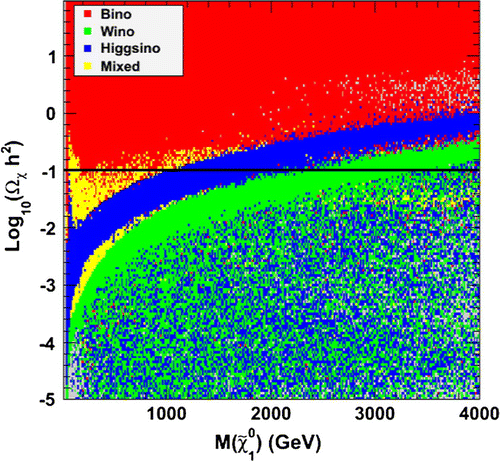
Other important constraints come from the dark matter direct detection experiments such as XENON 100 (Aprile et al., Citation2012) and LUX (Akerib et al., Citation2014). These experiments are sensitive to the scattering of WIMPs with nuclei, and can set limits on the WIMP mass as well as their spin-independent scattering cross sections with protons in absence of detectionFootnote1. We compute the neutralino scattering cross section with micrOMEGAs (Belanger, Boudjema, Pukhov, & Semenov, Citation2009). In Figure , we present the neutralino spin-independent scattering cross section with protons as a function of the neutralino mass, for the different neutralino types. The higgsinos have larger scattering cross sections, and are therefore currently more probed by the XENON and LUX experiments. Winos have smaller cross sections, and will mostly be probed by the LZ experiment. Finally, binos interact only very weakly and are more likely to escape detection by the direct detection experiments.
Figure 9. Spin-independent scattering cross section of neutralinos with protons as a function of the lightest neutralino mass. The colour of the points denotes the dominant nature of the lightest neutralino. Notes: The solid lines show the latest XENON and LUX limits, the dashed line represents the prospective LZ limit and the dotted line represents the limit below which neutrinos will act as a large background for the dark matter searches.
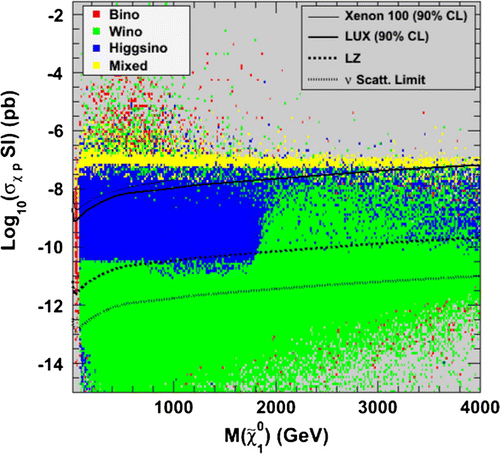
In Figure , the exclusion by the LUX experiment is shown in the parameter plane. It is clear that dark matter direct detection restricts mostly large
and small
values. One can notice that direct detection is complementary to the heavy Higgs and flavour physics searches since the same part of the parameter space is probed. Since in addition to
and
other MSSM parameters are also relevant for these searches, such redundancies are important to probe deeply the pMSSM parameter space.
6. Summary and conclusions
Direct SUSY and monojet searches, Higgs and flavour physics data, as well as dark matter constraints provide complementary information on the pMSSM parameters. To highlight the interplay between the different observables, in this section we pre-impose at the same time the constraints from Higgs physics, flavour physics and relic density.
In Figure , we show the fraction of excluded pMSSM points in the neutralino scattering cross section with matter vs. neutralino mass parameter plane, considering simultaneously constraints from SUSY direct searches and monojet searches. The limits from LUX are also displayed in the same plane. We first see that the LHC searches are complementary to dark matter direct detection, and probe different parts of the parameter space. In particular, LHC searches are sensitive to the strong sector of the MSSM, while direct dark matter detection is more sensitive to the neutralino sector. We also see that the LHC probes regions well below the LUX limits, and that monojet searches nicely increase the LHC discovery potential in the regions where the neutralino scattering cross section with matter is very small.
Figure 11. Fraction of pMSSM points excluded by the SUSY direct searches (left panel), in addition to the monojet searches (right panel), in the neutralino–proton scattering cross section vs. neutralino mass. Notes: The lines show the XENON-100 and LUX dark matter direct detection limits (Arbey et al., Citation2014).
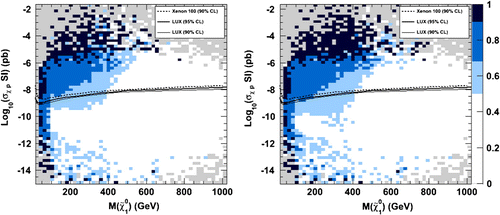
In Figure , the fraction of excluded points is shown as a function of the neutralino mass, and of the mass splitting between the lightest squark or gluino and the lightest neutralino. It shows that the SUSY and monojet searches probe more strongly scenarios with light neutralinos, excluding up to 65% of the points for light neutralinos, and that the dark matter direct detection limits can increase this exclusion up to 75%, presenting a nice complementarity between the two sectors. Additionally, the LHC searches are very powerful for mass splittings up to 700 GeV where more than 50% of the points are excluded, while direct detection is less dependent on the mass splittings.
Figure 12. Fraction of pMSSM points excluded by the SUSY direct searches, monojet searches and LUX data as a function of neutralino mass (left panel) and mass splitting between the lightest squark or gluino and the lightest neutralino (right panel).
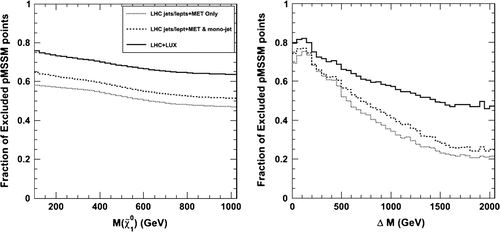
To conclude, we have demonstrated the synergy between the different observables of separate sectors, namely the LHC, flavour and dark matter sectors. During the next LHC run, this interplay will become even more important, either in the case no new phenomenon is found to ensure that no region of the parameter space remains uncovered, or in the case new phenomena or particles are discovered to allow for a determination of the underlying scenario and parameters.
Acknowledgements
This work was done in collaboration with Marco Battaglia to whom the authors are grateful. AA thanks the organizers of the “From Higgs to Dark Matter” 2014 Geilo Symposium for their invitation and support, and acknowledges partial support from the PEPS “Physique Théorique et ses Interfaces” of the CNRS.
Additional information
Funding
Notes on contributors
Alexandre Arbey
Alexandre Arbey and Farvah Mahmoudi are associate professors at University of Lyon and members of the CERN Theory Division. A Arbey is a cosmologist and astroparticle physics, working on the Dark Matter problem, as well as dark energy and Big-Bang nucleosynthesis. F Mahmoudi is a particle physics, specialist of Higgs, Flavour and Dark Matter physics. Their work consists in combining the constraints from all their sectors of expertise to constrain New Physics models. The project reported in this effort is performed in the context of Supersymmetry, but it can extend to other categories of particle physics scenarios beyond the Standard Model.
Notes
1 It should be noted that several independent dark matter experiments had claimed for possible detection of WIMPs of the order of 10 GeV (Bernabei et al., Citation2010; Aalseth et al., Citation2011, Angloher et al., Citation2012, Ahmed et al., Citation2011. While the pMSSM can provide scenarios compatible with such data (Arbey, Battaglia, & Mahmoudi, Citation2012a,Citation2013a), they are actually disfavoured by the latest LUX results.
References
- Aad, G., et al. (ATLAS Collaboration). (2012). Physics Letters B, 716, 1 (arXiv:1207.7214 [hep-ex]).
- Aalseth, C. E., et al. (2011). Physical Review Letters, 107, 141301 (arXiv:1106.0650 [astro-ph.CO]).
- AbdusSalam, S. S., Allanach, B. C., Quevedo, F., Feroz, F., & Hobson, M. (2010). Physical Review D, 81, 095012 (arXiv:0904.2548 [hep-ph]).
- Ahmed, Z., et al. (CDMS-II Collaboration). (2011). Physical Review Letters, 106, 131302 (arXiv:1011.2482 [astro-ph.CO]).
- Akerib, D. S., et al. (LUX Collaboration). (2014). Physical Review Letters, 112, 091303 (arXiv:1310.8214 [astro-ph.CO]).
- Alwall, J., et al. (2014). Journal of High Energy Physics, 1407, 079 (arXiv:1405.0301 [hep-ph]).
- Angloher, G., et al. (2012). European Physical Journal C, 72, 1971 (arXiv:1109.0702 [astro-ph.CO]).
- Aprile, E., et al. (XENON100 Collaboration). (2012). Physical Review Letters, 109, 181301 (arXiv:1207.5988 [astro-ph.CO]).
- Arbey, A., Battaglia, M., Djouadi, A., & Mahmoudi, F. (2012). Journal of High Energy Physics, 1209, 107 (arXiv:1207.1348 [hep-ph]).
- Arbey, A., Battaglia, M., Djouadi, A., & Mahmoudi, F. (2013). Physics Letters B, 720, 153 (arXiv:1211.4004 [hep-ph]).
- Arbey, A., Battaglia, M., & Mahmoudi, F. (2012a). European Physical Journal C, 72, 2169 (arXiv:1205.2557 [hep-ph]).
- Arbey, A., Battaglia, M., & Mahmoudi, F. (2012b). European Physical Journal C, 72, 1847 (arXiv:1110.3726 [hep-ph]).
- Arbey, A., Battaglia, M., & Mahmoudi, F. (2012c). European Physical Journal C, 72, 1906 (arXiv:1112.3032 [hep-ph]).
- Arbey, A., Battaglia, M., & Mahmoudi, F. (2013a). Physical Review D, 88, 095001 (arXiv:1308.2153 [hep-ph]).
- Arbey, A., Battaglia, M., & Mahmoudi, F. (2013b). Physical Review D, 88(1), 015007 (arXiv:1303.7450 [hep-ph]).
- Arbey, A., & Mahmoudi, F. (2008). Physics Letters B, 669, 46 (arXiv:0803.0741 [hep-ph]).
- Arbey, A., Battaglia, M., & Mahmoudi, F. (2014). Physical Review D, 89(7), 077701 (arXiv:1311.7641 [hep-ph]).
- Arbey, A., Battaglia, M., Mahmoudi, F., & Martinez Santos, D. (2013). Physical Review D, 87(3), 035026 (arXiv:1212.4887 [hep-ph]).
- ATLAS Collaboration. (XXXXa). Note ATLAS-CONF-2013-047.
- ATLAS Collaboration. (XXXXb). Note ATLAS-CONF-2013-053.
- Arbey, A., & Mahmoudi, F. (2010a). Journal of High Energy Physics, 1005, 051 (arXiv:0906.0368 [hep-ph]).
- Arbey, A., & Mahmoudi, F. (2010b). Computer Physics Communications, 181, 1277 (arXiv:0906.0369 [hep-ph]).
- ATLAS Collaboration. (XXXXc). Note ATLAS-CONF-2013-049.
- ATLAS Collaboration. (XXXXd). Note ATLAS-CONF-2013-035.
- Arbey, A., Battaglia, M., Djouadi, A., Mahmoudi, F., & Quevillon, J. (2012). Physics Letters B, 708, 162 (arXiv:1112.3028 [hep-ph]).
- ATLAS Collaboration. (XXXXe). ATLAS-CONF-2013-068.
- Belanger, G., Boudjema, F., Pukhov, A., & Semenov, A. (2009). Computer Physics Communications, 180, 747 (arXiv:0803.2360 [hep-ph]).
- Bernabei, R., et al. (DAMA and LIBRA Collaborations). (2010). European Physical Journal C, 67, 39 (arXiv:1002.1028 [astro-ph.GA]).
- Cahill-Rowley, M., Cotta, R., Drlica-Wagner, A., Funk, S., Hewett, J., Ismail, A., ... Wood, M. (2015). Physical Review D, 91(5), 055011 (arXiv:1405.6716 [hep-ph]).
- Cahill-Rowley, M. W., Hewett, J. L., Hoeche, S., Ismail, A., & Rizzo, T. G. (2012). European Physical Journal C, 72, 2156 (arXiv:1206.4321 [hep-ph]).
- Chatrchyan, S., et al. (CMS Collaboration). (2012). Physics Letters B, 716, 30 (arXiv:1207.7235 [hep-ex]).
- CMS Collaboration. (XXXXa). CMS-PAS-SUS-12-030.
- CMS Collaboration. (XXXXb). CMS-PAS-SUS-13-020.
- CMS Collaboration. (XXXXc). CMS-PAS-EXO-12-048.
- Conley, J. A., Gainer, J. S., Hewett, J. L., Le, M. P., & Rizzo, T. G. (XXXX). (arXiv:1103.1697[hep-ph]).
- Djouadi, A., et al. (MSSM Working Group Collaboration). (XXXX). hep-ph/9901246.
- Gelmini, G., Gondolo, P., Soldatenko, A., & Yaguna, C. E. (2006). Physical Review D, 74, 083514 (hep-ph/0605016).
- Kamionkowski, M., & Turner, M. S. (1990). Physical Review D, 42, 3310.
- Kowalska, K., Roszkowski, L., Sessolo, E. M., & Trojanowski, S. (2014). Journal of High Energy Physics, 1404, 166 (arXiv:1402.1328 [hep-ph]).
- Mahmoudi, F. (2008). Computer Physics Communications, 178, 745 (arXiv:0710.2067 [hep-ph]).
- Mahmoudi, F. (2009). Computer Physics Communications, 180, 1579 (arXiv:0808.3144 [hep-ph]).
- Mahmoudi, F., Neshatpour, S., & Virto, J. (2014). European Physical Journal C, 74(6), 2927 (arXiv:1401.2145 [hep-ph]).
- Ovyn, S., Rouby, X., & Lemaitre, V. (XXXX). (arXiv:0903.2225 [hep-ph]).
- Pumplin, J., Stump, D. R., Huston, J., Lai, H. L., Nadolsky, P. M., & Tung, W. K. (2002). Journal of High Energy Physics, 0207, 012 (hep-ph/0201195).
- Sekmen, S., Kraml, S., Lykken, J., Moortgat, F., Padhi, S., Pape, L., ... Spiropulu, M. (2012). Journal of High Energy Physics, 1202, 075 (arXiv:1109.5119 [hep-ph]).
- Sjostrand, T., Mrenna, S., & Skands, P. Z. (2006). Journal of High Energy Physics, 0605, 026 (hep-ph/0603175).
- Sjostrand, T., Mrenna, S., & Skands, P. Z. (2008). Computer Physics Communications, 178, 852 (arXiv:0710.3820 [hep-ph]).

